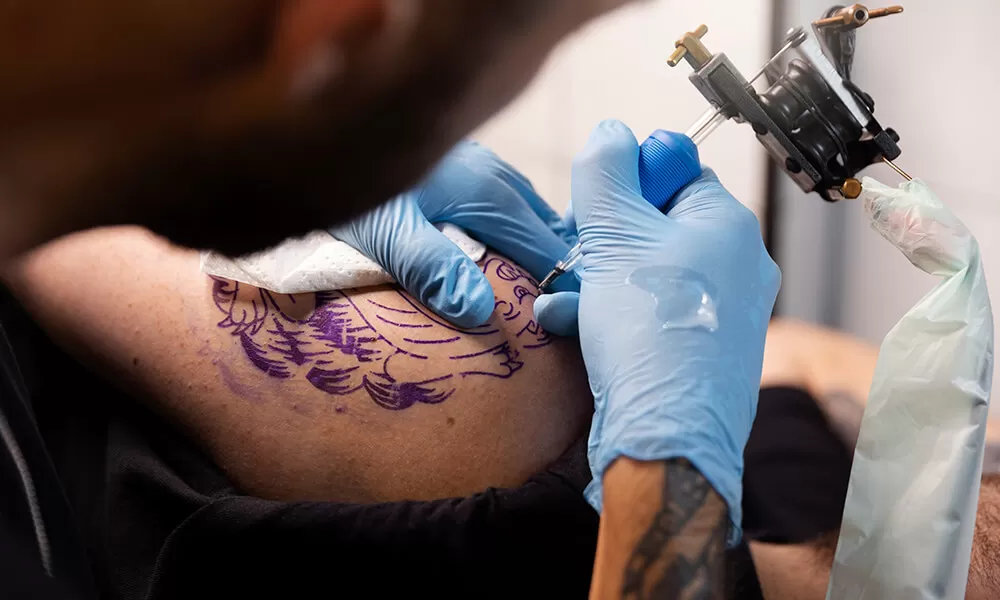Geen onderdeel van een categorie
How Painful is an Elbow Tattoo?
A tattoo on the elbow is a popular choice for many, but it raises a lot of questions, especially about the pain. The elbow is a complex area with thin skin, bones, and little fat, making it a unique and sometimes challenging place for a tattoo. If you’re considering getting an elbow tattoo, you might wonder how painful this process will be. We’ll guide you through this process in this article.
Why Do People Choose an Elbow Tattoo?
An elbow tattoo can look incredibly impressive. The area provides an interesting canvas for creativity and unique designs, such as mandalas, flowers, or geometric patterns that accentuate the natural shape of the elbow. The choice of an elbow tattoo can also be symbolic, marking a milestone or an important aspect of someone’s life.
Is an Elbow Tattoo Painful?
The pain of an elbow tattoo varies greatly from person to person. Many people describe the elbow as one of the most painful places to get a tattoo due to several factors:
- Thin Skin and Bone: The skin on the elbow is thin and close to the bone, meaning the needle often comes into direct contact with the bone, causing intense pain.
- Little Fat: The elbow has little fatty tissue, which usually helps to cushion the pain. Without this buffer, the pain is much sharper.
- Many Nerve Endings: The elbow contains many nerve endings, adding to the sensation of pain during tattooing.
- Movement Sensitivity: Because the elbow is a constantly moving joint, the pain of an elbow tattoo can be more intense due to the movement of the joint during the tattooing process.
Due to the painful nature of the elbow area, you should seriously consider using numbing cream. Check out our salves to find the one that suits you best.
Most Painful Areas of an Elbow Tattoo
While the elbow is generally considered a painful spot, some areas hurt more than others:
- Directly on the Elbow Tip: The most painful area for an elbow tattoo is directly on the tip of the elbow. Here, the skin is thinnest and the needle comes closest to the bone, causing a sharp, almost electric pain.
- Inner Elbow: The inside of the elbow, where the skin is thin and sensitive, can also be extremely painful. This area has many nerve endings and little fatty tissue to cushion the pain.
Least Painful Areas of an Elbow Tattoo
While the elbow is generally considered a painful spot, some areas can be slightly less painful:
- Outside of the Elbow: The outside of the elbow, where the skin is a bit thicker and there is more muscle tissue, can be less painful compared to the elbow tip.
- Around the Joint: Areas around the elbow joint can also be less painful, depending on the amount of fat and muscle tissue in that area.
Does Numbing Cream Help for an Elbow Tattoo?
For those worried about the pain of an elbow tattoo, numbing cream can be an incredibly effective solution. These creams are applied to the skin before the session to numb the nerve endings and reduce pain. Numbing cream can significantly reduce pain, especially in sensitive areas like the elbow. Check out our shop to find the right numbing cream for you. It’s important to apply the cream as directed by the manufacturer.
Preparing for an Elbow Tattoo
Being well-prepared can help make the experience of getting an elbow tattoo less painful. Ensure you are well-rested and hydrated. Avoid alcohol and blood-thinning medications before your session. Consider using numbing cream to reduce pain. By doing thorough research on which numbing cream suits you best, you can attend your appointment with more confidence, knowing the pain will be much less. This will mentally help in preparing for the appointment.
Aftercare for an Elbow Tattoo
Aftercare is crucial for the healing of your elbow tattoo and can also help reduce pain and discomfort. Here are some aftercare tips:
- Cleaning: Keep the tattoo clean by gently washing it with antibacterial soap and lukewarm water. Avoid scrubbing.
- Hydration: Apply a thin layer of recommended ointment or lotion to keep the skin hydrated and help with the healing process.
- Protection: Avoid exposure to the sun and immersion in water until the tattoo is fully healed. Wear loose-fitting clothing to minimize friction.
- Rest and Recovery: Give your body time to heal. Overloading the elbow can slow the healing process and cause more pain.
The Healing Process of an Elbow Tattoo
The healing process of an elbow tattoo can be challenging due to the unique properties of the skin and the constant movement of the joint. Right after the tattooing, it’s important to take good care of the tattoo to prevent infections and ensure optimal healing.
The first stage of healing, which lasts about a week, is characterized by swelling, redness, and sensitivity. During this period, it’s crucial to keep the tattoo clean by gently washing it with antibacterial soap and lukewarm water. Avoid scrubbing and pat the skin dry with a clean towel.
In the following weeks, the skin will begin to flake and itch as the top layers renew. Apply a thin layer of recommended ointment or lotion to keep the skin hydrated and promote the healing process. It’s important not to scratch or pull at the flakes, as this can damage the tattoo.
Complete healing can take several weeks to several months, depending on individual factors and how well you care for your tattoo.
